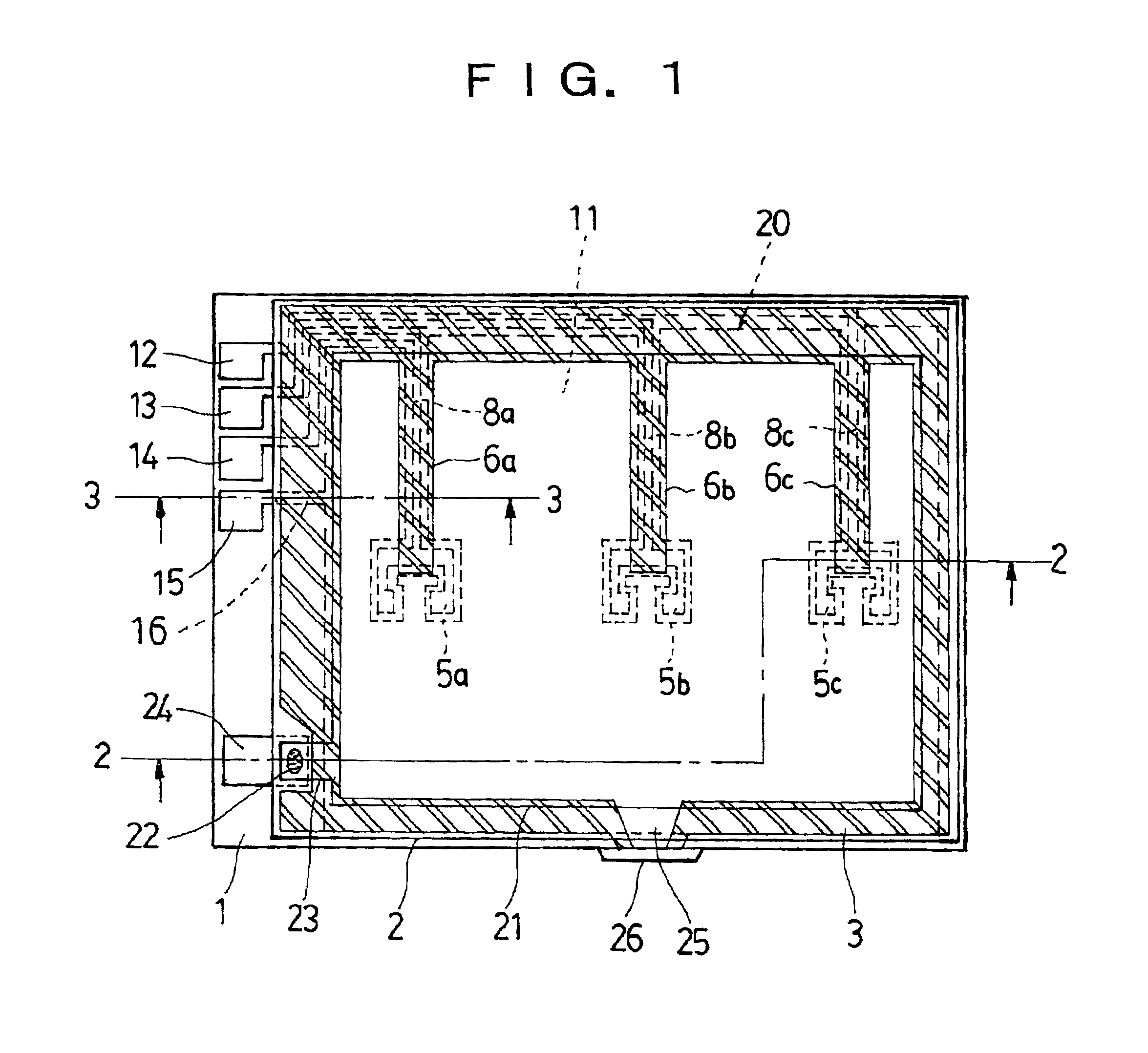Liquid crystal display panel
- Summary
- Abstract
- Description
- Claims
- Application Information
AI Technical Summary
Benefits of technology
Problems solved by technology
Method used
Image
Examples
modification example 2
FIG. 11 shows another example of a liquid crystal display panel devised for preventing defects from occurring to the periphery of wiring sealing sections. In FIG. 11 as well, parts corresponding to those in FIGS. 1 to 9 are denoted by like reference numerals for convenience in description.
In this example, a peripheral sealing section 3 is formed of a sealing material different from that for wiring sealing sections 6a, 6b, 6c. That is, the wiring sealing sect 6a, 6b, 6c are formed of a sealing material lower in hardness, and softer (greater in elastic coefficient) than that for the peripheral sealing section 3.
As described hereinbefore, the peripheral sealing section 3 has functions of hermetically sealing a liquid crystal layer, keeping a given spacing between a first substrate and a second substrate, and protecting the liquid crystal layer from an ambient environment, and accordingly, an epoxy resin based adhesive with moderate hardness is used as the sealing material thereof.
For t...
second embodiment
Subsequently, a second embodiment of a liquid crystal display panel according to the invention, and a modification example thereof are, described with reference to FIGS. 13 to 15. In the figures as well, parts corresponding to those of the first embodiment, shown in FIGS. 1 to 11, are denoted by like reference numerals, and description thereof is omitted or simplified.
FIG. 13 is a plan view similar to FIG. 1 showing the second embodiment of the liquid crystal display panel according to the invention, and FIG. 14 is a sectional view taken along line 14--14 in FIG. 13, showing different cross sections thereof in the same plane.
The liquid crystal display panel according to the second embodiment is also a case wherein the present invention is applied to a liquid crystal display module used for a viewfinder of a camera, in which the liquid crystal display panel is provided with a light source causing light to fall on a liquid crystal layer from a side face of the liquid crystal display p...
modification example
A modification example wherein the liquid crystal display panel according to the second embodiment of the present invention is partially modified is described hereinafter with reference to FIG. 15. FIG. 15 is a sectional view of the modification example similar to FIG. 14.
This liquid crystal display panel differs from the liquid crystal display panel shown in FIGS. 13 and 14 only in that an ultraviolet cutoff film 41 is installed on the external face of the first substrate 1 and the second substrate 2, respectively.
With these liquid crystal display panels, the smaller the width of a gap G3 formed between a target electrode 5b (the same applies to 5a and 5c) and a peripheral electrode 11 is, the easier a transparent state can be caused to occur over the entire display region. However, in order to enable a viewer to recognize beforehand a location of a target pattern for auto focus, it is preferable that the target pattern can be dimly seen, and accordingly, the width of the gap G3 ha...
PUM
| Property | Measurement | Unit |
|---|---|---|
| Color | aaaaa | aaaaa |
| Shape | aaaaa | aaaaa |
| Electric potential / voltage | aaaaa | aaaaa |
Abstract
Description
Claims
Application Information
 Login to View More
Login to View More - R&D
- Intellectual Property
- Life Sciences
- Materials
- Tech Scout
- Unparalleled Data Quality
- Higher Quality Content
- 60% Fewer Hallucinations
Browse by: Latest US Patents, China's latest patents, Technical Efficacy Thesaurus, Application Domain, Technology Topic, Popular Technical Reports.
© 2025 PatSnap. All rights reserved.Legal|Privacy policy|Modern Slavery Act Transparency Statement|Sitemap|About US| Contact US: help@patsnap.com



